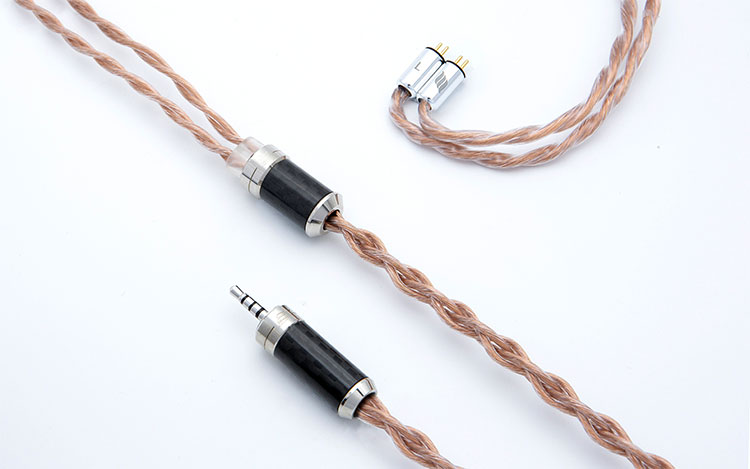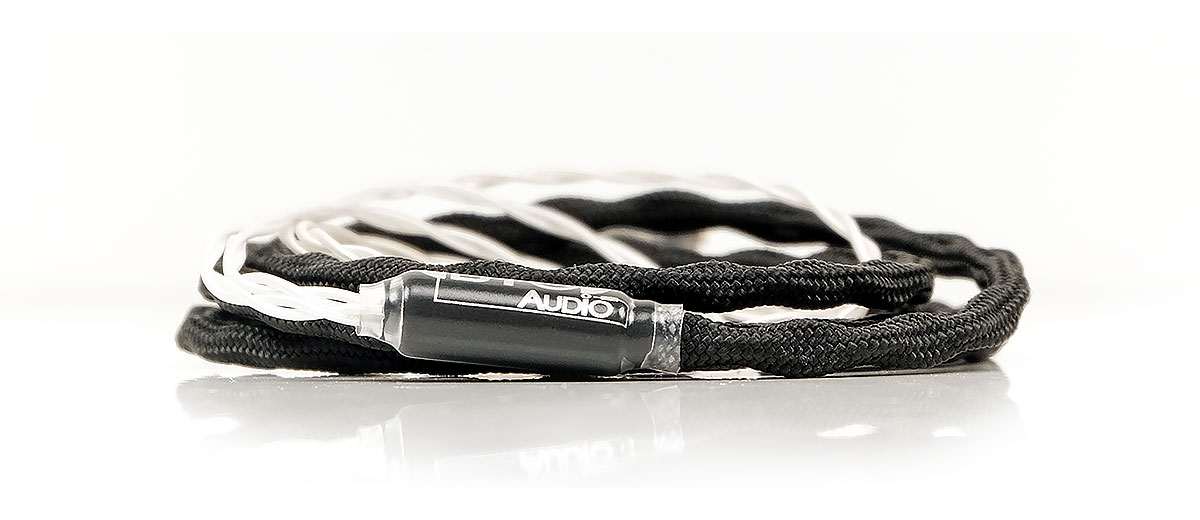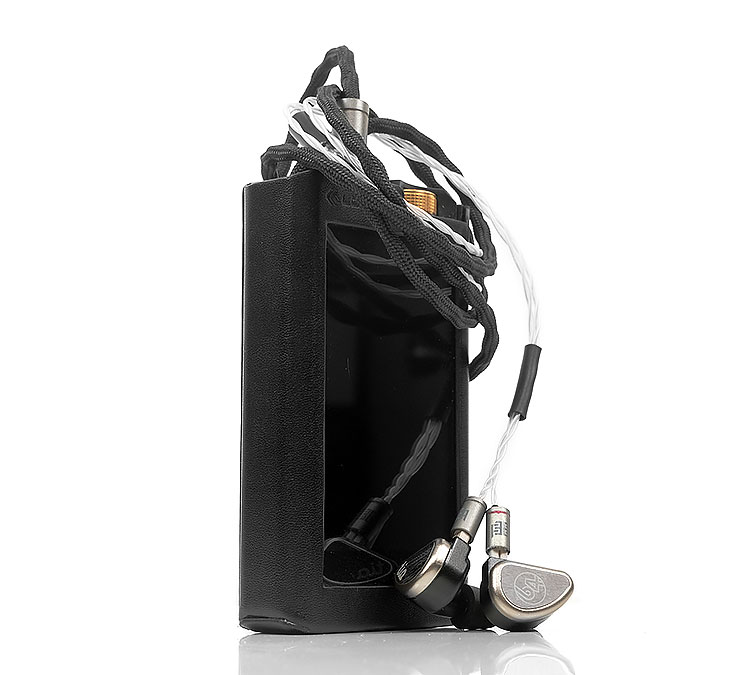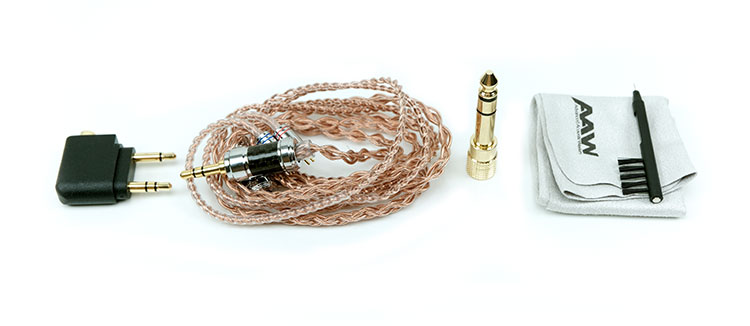Sound Impressions
Timbre
The Starlight delivers a fairly traditional SPC-like tone to our test monitors as well as an interesting contrast to the pure copper variants at this price point such as the EA Ares II and AAW’s Tiburon cables which have the same wire and gauge count (4-wire, 25AWG).
The emphasis on timbre here is neutral to a slightly forward treble presence and additional upper-mids focus as a result of the energetic treble performance. Towards the low-end, you do get a bit of copper overtone but not as meaty as the pure copper cables full-bodied sound.
It is punchy but fairly tight and doesn’t overly emphasize quite in the same manner as, say, the OC Studio Orpheus MK5. I would not call it an overly warm low-end but there is some mid-bass elevation that injects a little bit of warmth into the instrumental timbre in the lower-mids.
Further into the mids and upper mids you get that odd-harmonic overtone from the energetic treble presence. The timbre starts to become a touch drier and more neutral or cleaner to my ear. This will suit those who enjoy a bit more “zip” or clarity to their percussion and acoustic timbre.
This signature is more on articulation, speed and you will find yourself drawn to the mids and treble detail when pairing the Starlight to monitors that are more than capable of producing an airy treble performance.
Dynamic Range
The 4-wire 26AWG silver-plated OFC wiring is as competitive as any other aftermarket 26AWG cable out there today in terms of dynamic range and resolution. In fact, you may perceive there to be a little more detail the higher up the FR you go because of the feistier lower treble tuning.
Our copper competitors such as the Tiburon and Ares II seemed a touched rolled-off by comparison though nothing shelved down, rather just a change in the timbre emphasis from neutral and clean to warmer and smoother.
Even the SPC Reference 8 from ALO Audio seems a little more relaxed on the high-end though I would say there was a slight edge in the dynamic range possible given its 8-wire count.
Staging
The Starlight excels in creating an open and airy soundstage. Maybe it is my perception of how much more treble presence there is in the mix compared to stock cables such as Westone’s EPIC or a generic Plastic’s One but certainly compared to the Reference 8 and Tiburon from AAW you can pick it out a lot more clearly.
That treble presence, in turn, extends the staging out and upwards and creates some nice space for vocals and instruments to breathe as well as allowing for some good percussion presence.
I particularly enjoyed the DX200/AMP1 MKII source pairing though I will admit this creates what is popularly known here as the “Asian sound”.
Plenty of air, plenty of highs, good vocal and upper-mids clarity but perhaps slightly less low-end depth and body. Yes, it is punchy on the low-end but not quite as nicely layered or powerful as the Reference 8 from ALO or the Ares II from Effect Audio.
Overall, this is a good cable for synth wave and old-school trance genres in particular. If you want a bit of treble and upper mids sparkle and a nice punchy mid-bass with a generally clean-sounding timbre then the Starlight is a good choice.
Matchability
I tended to find the BTG-Audio Starlight CIEM cable to match very well with warmish sounding monitors or those that needed a solid upgrade from 4-wire OFC stock cables that suffered from a lack of dynamic range and treble articulation or headroom.
If you are fine-tuning then it is ideal to gently push the treble sparkle and upper mids presence a bit more into the mix, especially if your monitor or setup is too relaxed or warm for your taste. During our testing, we worked with 4 different monitors; the Noble Khan, Campfire Audio Solaris, the Jomo Audio Trinity and 64 Audio’s Trio.
Testing Monitors
64 Audio Trio
Out of those tested the 64 Audio Trio and the Trinity sounded the most impressive (paired with Lotoo PAW Gold Touch and iBasso DX220). I was half expecting the Tri0 to maybe sound a little thin or bright with the Starlight but not so.
The Starlight pairing kept the top-end of the Trio relatively smooth, a little drier yes, but nothing walled-in or harsh sounding whilst at the same time delivering a fairly punchy low-end.
Jomo Audio Trinity
The Jomo Audio Trinity has a reasonably relaxed top-end for an e-stat monitor so it paired quite well with the energetic Starlight. Normally the Trinity pairs with the Ares II and it does bring out a beautiful vocal and great low-end layering with Effect Audio’s copper cable.
However, the Starlight takes it in a different direction. A little less layering but more e-stat presence which changes the upper mids timbre ever so slightly towards something more neutral. It is a nice twist or alternative to the stock sound.
Noble Audio Khan/Campfire Audio Solaris
The Khan and Solaris I felt paired better with pure copper cables of equal AWG and performance. Cables such as the AAW Tiburon has that pure ‘copper’ slightly warmer and softer tone to it and that translates into a slightly fuller sound and more rolled-off highs.
The Khan and Solaris highs are a delicate balancing act without some EQ on neutral sources. The Starlight didn’t make them harsh sounding but certainly a lot more dominant.
Select Comparisons
Effect Audio Ares II
$149.90
Technical
The Ares II is Effect Audio’s entry-level cable in their Premium series priced not too far off the Starlight. This is a 26AWG 4-wire much like the Starlight but uses a UPOCC Litz Copper in a multi-sized stranded design compared to the Starlight’s 19-strand 26AWG silver-plated OFC (oxygen free copper) wire.
The Ares II also uses a translucent PVC jacket without any nylon sheath compared to the slightly stiffer LLDPE jacket of the Starlight. Overall, the Ares II is a better performer for microphonics and a little more pliant and easier to manage.
I do, however, prefer the Eidolic 2-pin connectors compared to the slightly flimsier sliding chrome-finished alloy barrels on the Ares II. Like the Starlight, you do get plenty of jack options for the Ares II including 2.5mm, 3.5mm, 4.4mm, as well as right-angled.
In this sample, ours is right-angled. The Ares II can also be terminated with a few more connector options beyond MMCX and 2-pin including JH Audio to name but a few.

Performance
Comparing these two using the Jomo Audio Trinity, I found both the FR emphasis and tone of the two to contrast, particularly on the mids and vocals. The copper wire of the Ares II will produce a slightly softer timbre and there is a greater degree of top-end roll-off or simply not as forward sounding as the Starlight.
Normally, I treat the Ares II as fairly neutral for a copper cable but compared to the Starlight it does seem to have a bit more mids focus whereas the Starlight is possibly even more neutral going ever so slightly brighter, especially in the upper mids and treble. The Starlight vocals are cleaner but not as forward or as full-bodied as the Ares II on the Trinity.
Now the Ares II has a more neutral low-end compared to the Tiburon but it still has a decent level of warmth and body. The Starlight isn’t lean either but it has this little bit of bloom going into the lower-mids that I don’t find with the Ares II on the Trinity test monitor. The Ares II seems to have just a bit more separation and better layering on the low-end compared to the Starlight.
Null Audio Tiburon
$169
Technical
Slightly more expensive than the Starlight, the Tiburon is a 1.2m 26AWG UPOCC Litz wire cryogenically treated and cross-braided and housed in a translucent PVC jacket.
The barrels on the Tiburon are a much heavier solid aluminum alloy with a carbon fiber weave finish and you can pretty much order most jack terminations like the Starlight. These include 2.5mm, 3.5mm, 4.4m, right-angled, and even 4-pin XLR. Connector options are even more varied with 2-pin, MMCX, Shure, and bass control options to name but a few.
You can also fine-tune the Y-split barrels for an additional cost on the Tiburon with some lighter options such as Purple Heart and African Blackwood. Because our sample comes with aluminum barrels and y-splitter the Eidolic terminated Starlight does feel the much lighter cable. It is also the easier of the two to use for glasses.
However, the Tiburon PVC insulation deadens the cable nicely, making it softer, more pliant, and more noise-free. The Starlight just feels a little stiffer and noisier beyond the nylon sheet and Y-splitter.
Performance
This is a fairly ‘copperish’ signature with a slightly wetter presentation, a bit more sweetness in the mids and slightly more low-end body. You could call it a more natural or smoother tone with a bit more weight and warmth.
The Starlight is cleaner sounding with a more neutral instrumental timbre and more treble presence. Comparing the two, for instance, on the Noble Khan the Starlight produced a more aggressive e-stats driver presence and a slightly harder and drier sound.
Nothing that I would call peaky or sibilant but definitely more bias to the upper mids and treble. The Tiburon pulled it back a bit more creating a slightly softer sound.
This is one of preference for me because both cables delivered similar levels of dynamic range it is just a matter of where you want your detail and specific area of the FR amplified. The Starlight offers more for vocal, upper mids, and treble presence and articulation. The Tiburon delivers a bit more instrumental warmth and low-end body.
ALO Audio Reference 8
$299
Technical
The 1.2m Reference 8 is the most expensive cable in our comparisons but similar in core material using 4-wire silver-plated copper mixed with four OCC copper conductors.
Reference 8 uses a translucent FEP jacket that shows off an attractive hue of copper and silver wire on the outside. It also keeps the entire cable fairly slimline and very lightweight compared to the other cables including the Starlight.
However, I find the Reference 8 a fairly stiff cable compared to the Starlight’s soft nylon finish with more ‘flyaway’ characteristics and a touch more memory retention.
Reference 8 uses a fairly beefy actual memory hook coated materials that do a good job of shaping but do add a fair bit of bulk around the ear. Glasses uses will have issues with the Reference 8. I also find the Reference 8 marginally more microphonic than the Starlight during use.
The Reference 8, like the Starlight, only comes in MMCX and 2-pin connector format. The connectors are nothing special but are lightweight. Like the Starlight, there is a more expansive jack range to pick from on the ALO Audio website including 3.5mm, 2.5mm, 4.4mm and something unique with a lighting connection. All at no additional charge.
Performance
Though both are SPC and relatively energetic signatures there are some differences, particularly in how much they emphasize the mids and treble and the general level of warmth.
Reference 8 comes across as the slightly warmer of the two with a bit more low-end bloom when paired with our test IEM, the Solaris. It also has a slightly richer but softer harmonic tone in its instrumental timbre and sounds a little more relaxed to rolled-off on the top-end.
The Starlight is more of a classic SPC sound for me, with a punchier and slightly cleaner low-end and not quite as much warmth as the Reference 8. You lose a tiny bit of body but I think it sounds a touch more spacious as a result.
Treble is a little cleaner sounding for me on the Starlight, perhaps a little harder-edged but not too much. What it does is inject a little more odd-harmonic overtone into the upper mids and midrange instrumental timbre so it sounds the cleaner more neutral of the two cables.
It also comes across as a little drier than the Reference 8 tone but carries a bit more energy and presence for vocals and percussion.
Our Verdict
The BTG-Audio Starlight brand has been around I think forever. That might just be a slight overstatement but the old-school vibe is there if not the new-school price. Thank god for that in many ways because Brain could easily have charged another $100 for the Starlight and it would not have looked out of place in today’s cable market.
As such you get a competitive cable for $125 and one that competes well with cables $150 upwards. You do, however, get a sound tweak away from the usual richer copper hue of those $150 cables and something a little ‘spicier’, cleaner and certainly from the upper mids upwards, more energetic.
In some ways, this is a classic SPC sound but given the ALO Audio Reference 8 is also SPC and sounds a little warmer, perhaps the Starlight sound is now a little more ‘unique’.
This is a cable that I feel is ideal for warm or relaxed monitors that you may want to liven up a bit. A cable that perhaps plays to the strengths of monitors also that enjoy casting spacious amounts of headroom and good articulation such as the 64 Audio Trio.
The Starlight won’t break the bank either making it a viable first-time upgrade for those that want to jump beyond compressed sounding lifeless stock cables that a lot of good monitors come with.
Starlight Specifications
- 1.2m Length
- 19-strand 26AWG silver-plated OFC (oxygen-free copper)
- LLPDE insulation, black Nylon jacket
- Eidolic Premium connector jacket and barrels





